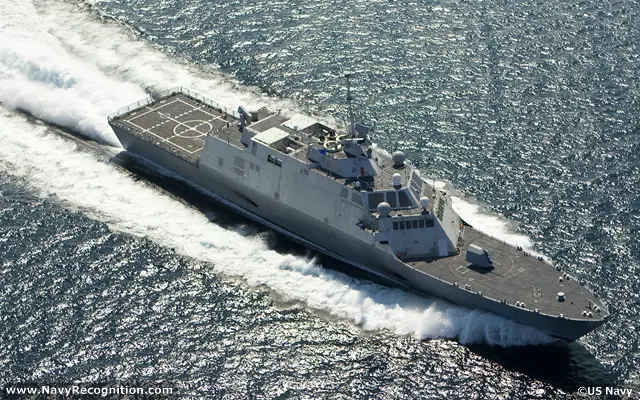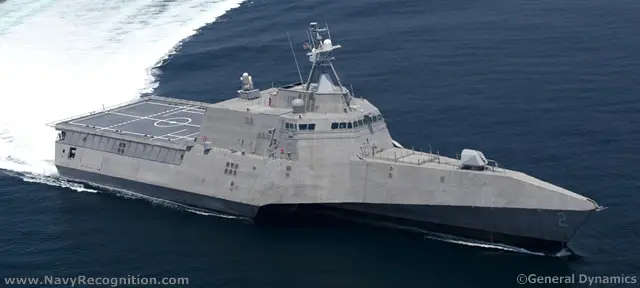 |
| USS Freedom LCS-1 |
 |
| Independence (LCS-2) |
U.S. GAO - Littoral Combat Ship: Navy Complied with Regulations in Accepting Two Lead Ships, but Quality Problems Persisted after Delivery
What GAO Found
Navy decisions to accept the first two littoral combat ships (LCS)—LCS 1 and LCS 2—in incomplete, deficient conditions complied with the Federal Acquisition Regulation's (FAR) acceptance provisions, largely due to the cost-reimbursement type contracts in place to construct these ships. The Navy also met FAR requirements related to responsibility for and place of acceptance, among other provisions, by using an authorized Navy representative to accept each ship at its respective contractor's facility. Under the cost-reimbursement contracts, the LCS 1 and LCS 2 prime contractors were only required to give their best efforts to complete quality-related activities—along with the other work specified in the contracts—up to each contract's estimated cost. These efforts resulted in both ships not completing all required sea trials—tests that evaluate ships' overall quality and performance against contractual requirements—including acceptance and final contract trials, as shown in the table below.
Navy decisions to accept delivery of LCS 1 and LCS 2 in incomplete, deficient conditions were driven by a focus on near-term cost performance by shipbuilders, a desire to introduce the long-delayed ships to the fleet, and—in the case of LCS 1—environmental and treaty considerations associated with the location of that ship’s construction. In prioritizing these factors, the Navy shortchanged its quality assurance processes for both ships, which has caused it to devote considerably more time and money to resolving deficiencies post-delivery than anticipated. However, because the Navy did not establish clear deadlines for resolving ship deficiencies, corrections were allowed to lag, to the point that fleet operators inherited unresolved starred deficiencies on each seaframe. Further, these deficiencies have constrained recent shipboard operations.
On both LCS 1 and LCS 2, the Navy deferred testing of systems, including key weapons systems such as the 57-millimeter gun, until after the ships’ first set of acceptance trials. Further, mission package equipment—critical to LCS mission execution—was not tested as a part of either ship’s acceptance trials. Consequently, key interfaces between the seaframes and mission package equipment—particularly, seaframe launch, handling, and recovery systems—remained undemonstrated at initial acceptance trials. Further, neither ship had acquired required third-party certifications for certain navigation, aviation, and tactical data link systems. Consequently, the Navy was not able to fully demonstrate the uncertified systems prior to delivery.U.S. GAO - Navy Shipbuilding: Significant Investments in the Littoral Combat Ship Continue Amid Substantial Unknowns about Capabilities, Use, and Cost
The Navy continues to buy early increments of LCS mission packages before (1) defining requirements and cost, schedule, and performance goals for each increment, as currently required by DOD policy and (2) completing developmental testing, which to date has identified problems with system performance. This evolutionary acquisition strategy, which delivers improving levels of capability over several increments, offers warfighters improved capability as it is available. However, the requirements for the increments have not yet been defined, and the increments will provide performance below the Navy's minimum needs for years to come. In addition, the Navy does not plan to demonstrate that the MCM and SUW packages can meet minimum--termed "threshold"--requirements until their final increments are fielded in 2017 and 2019, respectively. By that time, the Navy will have already procured more than 24 MCM and SUW mission packages. Further, developmental testing to date--especially for the systems comprising the MCM package--has shown performance problems. Internal Navy studies and wargames have also raised concerns with the overall effectiveness of each mission package based on inherent seaframe or mission module limitations.LCS: U.S. Navy Complied with Regulations, but Quality Problems Persisted after Delivery
The U.S. Navy decisions to accept the first two littoral combat ships (LCS)—LCS 1 and LCS 2—in incomplete, deficient conditions complied with the Federal Acquisition Regulation's (FAR) acceptance provisions, largely due to the cost-reimbursement type contracts in place to construct these ships.
Navy decisions to accept delivery of LCS 1 and LCS 2 in incomplete, deficient conditions were driven by a focus on near-term cost performance by shipbuilders, a desire to introduce the long-delayed ships to the fleet, and—in the case of LCS 1—environmental and treaty considerations associated with constructing that ship adjacent to the Great Lakes. The Navy prioritized these factors over its quality assurance processes for both ships, which has caused it to devote considerably more time and money to resolving deficiencies after delivery than anticipated. However, because the Navy did not establish clear deadlines for resolving ship deficiencies, corrections were allowed to lag, to the point that fleet operators inherited unresolved deficiencies on each ship. These deficiencies have constrained recent shipboard operations.
The Navy also met FAR requirements related to responsibility for and place of acceptance, among other provisions, by using an authorized Navy representative to accept each ship at its respective contractor's facility. Under the cost-reimbursement contracts, the LCS 1 and LCS 2 prime contractors were only required to give their best efforts to complete quality-related activities—along with the other work specified in the contracts—up to each contract's estimated cost. These efforts resulted in both ships not completing all required sea trials—tests that evaluate ships' overall quality and performance against contractual requirements—including acceptance and final contract trials.
Law360, New York (July 25, 2013, 4:46 PM ET) -- Navy leaders on Thursday asked Congress for patience and a firm financial commitment to its new Littoral Combat Ship, saying early acquisition problems have been ironed out and that the new ship will allow the Navy to dominate shallow-water combat more cheaply than any other option.LCS: The USA’s Littoral Combat Ships
The $40 billion Littoral Combat Ship program has faced congressional scrutiny for defects, including recent power failures that forced the first ship to return to port early in its deployment, and for the Navy’s controversial decision to begin production on two separate versions of the ship before testing and development was finished.
Sept 25/14: GAO on lead ships. The GAO issues a report saying that the Navy technically stayed within acquisition regulations in its acceptance of the 2 lead ships, thanks to cost-reimbursement contractual clauses. But extensive use of waivers to expedite trials and acceptance for LCS 1 and LCS 2 for a variety of short-term concerns led to a lot of additional time and money spent later on.
A decade after the initial contract awards, that discussion may seem somewhat moot, but consequences are felt to this day:
“Even as of August 2014, the combat management system continued to face significant limitations, which has restricted its use during fleet operations.”
The LCS is a far less capable ship than the Navy needs and for what it does, far more expensive than American taxpayers can afford. Ongoing design defects and associated cost overruns have added hundreds of millions of dollars to the projected cost for a single LCS. At a projected construction cost of $220 million each and a projected mission-ready cost of $400 million, the LCS would have allowed the Navy to reverse the declining size of its surface force and prepare for future conflicts.2 In reality, the total cost of a mission-ready ship has nearly doubled to $780 million, and the Navy has been forced to cut payload options by 1/3.3 Because the LCS has been designed to perform a number of tasks adequately, it does few things well. Cancellation of new complementary warships (namely guided missile destroyers and air defense cruisers) exacerbates inherent shortcomings of the LCS by increasing expectations far beyond what it was nominally designed to do. The LCS is fundamentally under-armed, under-armored and under-crewed, giving it limited utility in littoral (near shore) waters and making it a non-asset in terms of surface combat strength.The littoral combat ship might not be living up to the Navy's promises - Washington Business Journal
How to Put Lipstick on a Pig: The Navy’s Littoral Combat Ship
Meet the Littoral Combat Ship (LCS). The Navy’s ship of the future costs over 200% more than it was supposed to, struggles to perform routine missions, and lacks the weapons or durability to survive combat. How do American taxpayers end up paying $34 billion for a warship that can’t go to war? Through a combination of extravagant Navy requirements, spineless Congressional oversight and willful contractor subterfuge. After a decade of these problems, in February 2014, Secretary of Defense Hagel cut the planned purchase of LCS from 52 to 32 and authorized the Department of the Navy to identify more “capable and lethal small surface combatant” alternatives. This is a positive step, but not the promise to cancel the LCS that the US Navy needs and American taxpayers deserve.


No comments:
Post a Comment